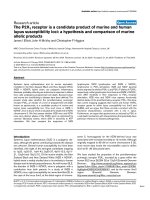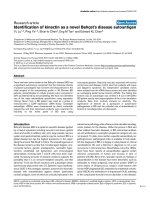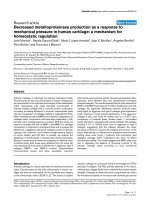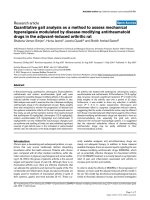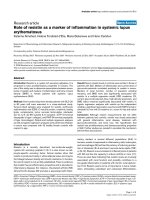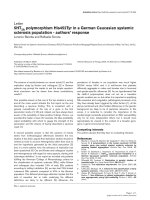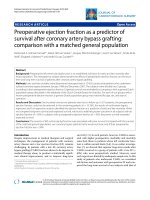Báo cáo Y học: Na+/K+-ATPase as a signal transducer Zijian Xie and Amir Askari docx
Bạn đang xem bản rút gọn của tài liệu. Xem và tải ngay bản đầy đủ của tài liệu tại đây (183.3 KB, 6 trang )
MINIREVIEW
Na
+
/K
+
-ATPase as a signal transducer
Zijian Xie and Amir Askari
Department of Pharmacology, Medical College of Ohio, Toledo, USA
Na
+
/K
+
-ATPase as an energy transducing ion pump has
been studied extensively since its discovery in 1957. Although
early findings suggested a role for Na
+
/K
+
-ATPase in
regulation of cell growth and expression of various genes,
only in recent years the mechanisms through which this
plasma membrane enzyme communicates with the nucleus
have been studied. This research, carried out mostly on
cardiac myocytes, shows that in addition to pumping ions,
Na
+
/K
+
-ATPase interacts with neighboring membrane
proteins and organized cytosolic cascades of signaling pro-
teins to send messages to the intracellular organelles. The
signaling pathways that are rapidly elicited by the interaction
of ouabain with Na
+
/K
+
-ATPase, and are independent of
changes in intracellular Na
+
and K
+
concentrations,
include activation of Src kinase, transactivation of the epi-
dermal growth factor receptor by Src, activation of Ras and
p42/44 mitogen-activated protein kinases, and increased
generation of reactive oxygen species by mitochondria. In
cardiac myocytes, the resulting downstream events include
the induction of some early response proto-oncogenes,
activation of the transcription factors, activator protein-1
and nuclear factor kappa-B, regulation of a number of
cardiac growth-related genes, and stimulation of protein
synthesis and myocyte hypertrophy. For these downstream
events, the induced reactive oxygen species and rise in
intracellular Ca
2+
are essential second messengers. In cells
other than cardiac myocytes, the proximal pathways linked
to Na
+
/K
+
-ATPase through protein–protein interactions
are similar to those reported in myocytes, but the down-
stream events and consequences may be significantly differ-
ent. The likely extracellular physiological stimuli for the
signal transducing function of Na
+
/K
+
-ATPase are the
endogenous ouabain-like hormones, and changes in extra-
cellular K
+
concentration.
Keywords: calcium ion; cardiac hypertrophy; cardiac
myocyte; epidermal growth factor; mitogen activated
protein kinase; Na
+
/K
+
-ATPase; ouabain; Ras; reactive
oxygen species; Src kinase.
INTRODUCTION
In 1957, J. C. Skou reported the discovery of the Na
+
/K
+
-
ATPase and proposed its role in the active extrusion of Na
+
from the nerve cell [1]. Soon thereafter, sufficient evidence
was available to establish that this enzyme is indeed the
molecular machine that uses the energy of hydrolysis of
ATP for the coupled active transports of Na
+
and K
+
(the
sodium pump) across the plasma membrane of nearly all
animal cells [2]. In the ensuing decades, extensive work has
been carried out on the structure–function of Na
+
/K
+
-
ATPase as an energy transducing ion pump. This research
has been summarized in numerous previous reviews and
monographs, and is updated in one of the accompanying
reviews [3]. Here, we address a newer aspect of the biology
of Na
+
/K
+
-ATPase; i.e. the mechanisms and the pathways
by which the enzyme acts as a signal transducer to relay
messages, through protein–protein interactions, from the
plasma membrane to the nucleus.
EARLY STUDIES ON THE ROLE OF
NA
+
/K
+
-ATPASEINGENEREGULATION
AND CELL GROWTH
It has been known for a long time that Na
+
/K
+
-ATPase
communicates with the nucleus to regulate genes and cell
growth. What is new is the realization that this communi-
cation occurs through the properties of Na
+
/K
+
-ATPase
that are distinct from its function as an ion pump.
That the enzyme is capable of controlling expression of its
own genes was suggested in 1974 [4]. Pressley [5] has
reviewed the studies of various groups showing that chronic
inhibition of the sodium pump of the cultured cells, either by
the pump inhibitor ouabain or by lowering of [K
+
]
o
,leads
to an increased abundance of functional Na
+
/K
+
-ATPase
in the plasma membrane; and that this increase is due, in
part, to the transcriptional up-regulation of the enzyme
subunits. In these and subsequent studies on the adaptive
upregulation of the enzyme due to its inhibition, the general
conclusion has been that the intracellular ionic changes
Correspondence to A. Askari, Department of Pharmacology,
Medical College of Ohio, 3035 Arlington Avenue, Toledo,
OH 43614-5804, USA.
Fax: + 1 419 383 2871, Tel.: + 1 419 383 4182,
E-mail:
Abbreviations: AP-1, activator protein 1; EGF, epidermal growth
factor; Grb2, growth factor receptor-bound protein 2; MAPK,
mitogen activated protein kinase; MEK, MAPK kinase; NF-jB,
nuclear factor kappa B; PKC, protein kinase C; PLC,
phospholipase C; Raf, a MAPK kinase kinase; ROS, reactive oxygen
species; Shc, SH-2 domain-containing protein; Sos, mammalian
homologue of Son-of-sevenless (a guanine nucleotide exchange
factor).
Enzyme:Na
+
/K
+
-ATPase (EC 3.6.1.8).
(Received 15 October 2001, revised 18 February 2002,
accepted 20 February 2002)
Eur. J. Biochem. 269, 2434–2439 (2002) Ó FEBS 2002 doi:10.1046/j.1432-1033.2002.02910.x
resulting from pump inhibition are responsible for the noted
regulation [5–8]. Over the years, the observed regulation by
ouabain or low [K
+
]
o
of a number of genes other than those
of the pump subunits have also been ascribed to altered
intracellular ionic concentration [9–14]. There is, however,
no direct evidence for the transcriptional regulation of any
of these genes by changes in [Na
+
]
i
or [K
+
]
i
that are
expected to result from pump inhibition.
A large body of work reviewed by Kaplan [15] showed, as
early as 1968 [16], that ouabain interaction with Na
+
/K
+
-
ATPase inhibits mitogen-induced differentiation and pro-
liferation of lymphocytes. Although these effects and
subsequent proliferative ouabain effects on some cells [17]
were also generally ascribed to altered intracellular ion
concentrations, it is of interest to note that later observa-
tions clearly suggested that some growth-related effects of
ouabain on lymphocytes may indeed be dissociated from
ouabain-induced changes in intracellular ions [18–20].
CONTROL OF GROWTH AND
GROWTH-RELATED GENES
BY NA
+
/K
+
-ATPASE IN CARDIAC
MYOCYTES
In mid-1990s, our laboratories became interested in the
possible role of Na
+
/K
+
-ATPase in the nonproliferative
growth (hypertrophy) of the heart. This was partly due to
the established, but relatively ignored, effects of ouabain on
lymphocyte growth mentioned above; and partly due to the
growing realization that the well known hypertrophy of the
failing heart may not be only an adaptive and beneficial
response of the diseased heart as stated in textbooks, but
rather a part of the continuum of the derangements leading
to advanced heart failure. Because of the latter, at the time
there was extensive ongoing research on the mechanisms by
which a variety of hormones, neurotransmitters, cytokines,
mitogens, and mechanical stimuli affect cardiac myocyte
hypertrophy [21]. Interestingly, in this highly active field,
there seemed to be no focus on how the cardiac Na
+
/K
+
-
ATPase and its clinically used specific inhibitors, the
digitalis drugs, may be involved in cardiac hypertrophy.
Considering that digitalis drugs were, and remain to be, a
mainstay of the treatment of the failing heart, it seemed to
us that exploration of the effects of these drugs on cardiac
hypertrophy deserved more attention. Using the cultured
cardiac myocytes as a model, our studies of the past few
years [22–26] have clearly indicated that the same nontoxic
concentrations of ouabain that cause partial inhibition of
Na
+
/K
+
-ATPase and an increase in cardiac contractility,
also stimulate myocyte growth and protein synthesis, induce
a number of early response proto-oncogenes, activate
transcription factors activator protein 1 (AP-1) and
NF-jB, and induce or repress the transcription of several
late-response cardiac marker genes that are also regulated
by other cardiac hypertrophic stimuli. These findings clearly
establish that Na
+
/K
+
-ATPase indeed regulates the growth
and the phenotype of the cardiac myocyte; and raise the
intriguing question of whether the altered levels or proper-
ties of Na
+
/K
+
-ATPase, either drug-induced, or by the
actions of endogenous digitalis-like compounds, or by other
pathological down-regulatory mechanisms, are involved in
the development of cardiac hypertrophy and failure. This
important question is not likely to be resolved in the near
future. In the highly active area of research on cardiac
hypertrophy, there has been some tendency to overempha-
size the importance of this entity or that pathway [27]. In
view of the multiplicity of the stimuli and receptors that
have been shown to regulate cardiac hypertrophy, and
because of the evident overlap and superficial similarities of
the signal pathways linked to such stimuli/receptors, it
would be naively optimistic to think that focus on one entity
and neglect of others may resolve the problem of cardiac
hypertrophy/failure. We suggest that it is more important to
recognize that multiple signals, receptors, pathways, and
second messenger are involved in the control of myocyte
growth, and that it is essential to delineate the pathways
activated by each signal/receptor, and the nature of cross-
talk among these, before the consequences of the patholo-
gical derangement of the interacting networks linked to
different receptors can be understood. In this context, the
mapping of the signaling pathways coupled to Na
+
/K
+
-
ATPase, and the clarification of the mechanisms involved in
pump interaction with neighboring receptors, has been the
focus of our recent research.
SECOND MESSENGERS, SIGNALING
INTERMEDIATES, AND PATHWAYS
LINKED TO CARDIAC NA
+
/K
+
-ATPASE
THROUGH PROTEIN–PROTEIN
INTERACTIONS
To date, most of the work on signal transduction by
Na
+
/K
+
-ATPase has been carried out on cardiac myocytes.
It is convenient to present the information on myocytes first,
and then discuss the emerging data on other cell types.
Figure 1 depicts a summary of the signal transducing
function of Na
+
/K
+
-ATPase and its consequences in
cardiac myocytes. It is appropriate to point out that while
all of our research cited below has been carried out on rat
cardiac myocytes, recent work on cardiac preparations from
other species (K. Mohammidi, L. Liu, P. Komentiani, Z. Xie
& A. Askari, unpublished results) shows that the indicated
conclusions are not limited to rat myocytes.
Pathways that are independent of changes
in intracellular ions
Because the cardiac myocyte plasma membrane contains a
highly active Na
+
/Ca
2+
-exchanger, the most significant
intracellular ionic change that results from the partial, but
nontoxic, inhibition of cardiac Na
+
/K
+
-ATPase is a rise in
[Ca
2+
]
i
, which has been known for decades to be the cause
of the positive inotropic action of a digitalis compound such
as ouabain [28]. When we first noted the hypertrophic and
the gene regulatory effects of ouabain on myocytes [22,23],
we made the reasonable assumption that these effects were
also caused by the rise in [Ca
2+
]
i
. It has turned out, however,
that an increase in [Ca
2+
]
i
is necessary but not sufficient for
the ouabain-induced hypertrophy and the associated gene
regulation. It is now evident that large segments of the early
events that result from ouabain interaction with cardiac
Na
+
/K
+
-ATPase are indeed independent of any changes in
intracellular Na
+
,K
+
,andCa
2+
concentrations, but
depend on the enzyme’s interaction with other proteins
[29,30]. The present state of knowledge about these proximal
pathways may be summarized as follows. The earliest
Ó FEBS 2002 Na
+
/K
+
-ATPase as a signal transducer (Eur. J. Biochem. 269) 2435
specific ouabain-induced event that has been identified is the
activation of Src kinase which leads to tyrosine phosphory-
lation of a number of cellular proteins, including the
epidermal growth factor (EGF) receptor [29]. Although it is
possible that other receptor or nonreceptor tyrosine kinases
may also be activated by ouabain, the transactivation of the
EGF receptor by Src is sufficient to account for the
recruitments of Shc (SH-2 domain-containing protein),
Grb2, Sos (a mammalian homologue of Son-of-sevenless),
and Ras to the plasma membrane [25,29]. Whether Src
interacts with Na
+
/K
+
-ATPase directly or indirectly is not
known [29]; this is the subject of ongoing studies. Upon
ouabain-induced activation of the G-protein Ras, a pathway
is initiated (the details of which are not known), which
clearly extends from the plasma membrane to the mito-
chondria where it leads to increase in generation of ROS
[26,30]. This increase in ROS is an essential second
messenger for many, but not all, of the downstream events
that are linked to Na
+
/K
+
-ATPase. The antioxidants,
N-acetylcysteine or vitamin E, which prevent this increase
in reactive oxygen species (ROS) block ouabain-induced
transcriptional regulation of the late-response marker genes,
but not the induction of c-fos [26]. Consistent with the latter,
ouabain-induced activation of the transcription factor AP-1,
which contains Fos, is also insensitive to antioxidants [26].
However, activation of NF-jB by ouabain is prevented
by antioxidants [26], suggesting that ouabain-induced regu-
lation of some late-response genes may involve this
transcription factor. Most significantly, antioxidants block
ouabain-induced stimulation of protein synthesis [26],
suggesting that the pathway beginning with Ras and leading
to ROS generation and NF-jB activation is essential to the
ouabain-induced hypertrophy of the cardiac myocyte.
Antioxidants attenuate but do not abolish ouabain-induced
p42/44 mitogen-activated protein kinase (MAPK) activa-
tion [26], suggesting the existence of a signal amplification
cycle consisting of Ras-dependent ROS generation and
ROS-dependent activation of Ras.
The role of increased [Ca
2
+]
i
Ouabain-induced activation of Ras, through the transacti-
vation of the EGF receptor by Src, not only leads to
mitochondrial ROS generation, but also to the activation of
p42/44 MAPK (also called ERK
1/2
) through the Ras/Raf/
MAPK kinase/MAPK cascade (where Raf is a MAPK
kinase kinase and MEK is a MAPK kinase) [29,30].
However, the activation of this cascade, unlike that of ROS
generation, also requires the rise in [Ca
2+
]
i
that is caused by
ouabain’s inhibition of the ion transporting function of
Na
+
/K
+
-ATPase [25]. One locus of this Ca
2+
effect has
now been identified. It turns out that ouabain-induced
activation of Ras is necessary but not sufficient for the
activation of Ras/Raf/MEK/MAPK cascade. Ouabain-
induced activation of protein kinase C (PKC) is also
required for MAPK activation [31], most likely due to
PKC activation of Raf whose recruitment to the membrane
has been induced by Ras. Unsurprisingly, activation of
PKC seems to be due to activation of phospholipase C
(PLC)-c that is also recruited to the ouabain-activated Src/
Fig. 1. The signal transducing function of Na
+
/K
+
-ATPase and its consequences in cardiac myocytes. Two pools of the enzyme, one pumping ions
and the other interacting with neighboring proteins are suggested by the data. The partial inhibition of the pump by ouabain causes a modest
change,ifany,in[Na
+
]
i
and [K
+
]
i
, but a significant change in [Ca
2+
]
i
due to the presence of the Na
+
/Ca
2+
-exchanger. Ouabain interaction with
the other pool alters protein–protein interactions to activate the indicated signaling pathways. The events placed in the grey box have been shown to
be independent of changes in [Na
+
]
i
,[K
+
]
i
,and[Ca
2+
]
i
that may occur. These activated pathways, the resulting increase in ROS, and the
concomitant increase in [Ca
2+
]
i
lead to activations of NF-jB and AP-1, transcriptional regulation of early response genes (c-fos, c-jun), and cardiac
growth-related genes (those of atrial natriuretic factor, skeletal a-actin, and the a
3
subunit of Na
+
/K
+
-ATPase), stimulation of protein synthesis,
and myocyte hypertrophy. The solid arrows indicate experimentally supported events induced by ouabain in myocytes, and the broken arrows
indicate those with limited or indirect support. In several cell types other than cardiac myocytes, some of the same signaling events are induced by
ouabain, but there are also significant cell-specific differences between the ouabain-induced pathways and the down-stream consequences (see text).
2436 Z. Xie and A. Askari (Eur. J. Biochem. 269) Ó FEBS 2002
EGF receptor complex [31]; it is this PKC activation that
requires the elevation of [Ca
2+
]
i
by ouabain [31]. There is,
however, evidence to suggest additional mechanisms by
which a rise in [Ca
2+
]
i
regulates the signaling events initiated
by ouabain. The Ca
2+
-calmodulin kinase also seems to be
involved in ouabain-induced activation of MAPK and
regulation of early and late-response genes [23–25] by
mechanisms yet to be clarified.
An important recent development is the finding that
when ouabain-induced activation of MEK and MAPK is
prevented, the ouabain-induced increase in [Ca
2+
]
i
is also
blocked [32], establishing the existence of another positive
feed-back cycle; i.e. the requirement of rise in [Ca
2+
]
i
for
MAPK activation, and the necessity of MAPK activation
for rise in [Ca
2+
]
i
.
Two pools of Na
+
/K
+
-ATPase with two distinct
but coupled functions
Based on the findings summarized above, it is clear that
interaction of nontoxic concentrations of ouabain with the
cardiac myocyte Na
+
/K
+
-ATPase leads to the generation
of two intracellular second messengers, increased ROS and
increased [Ca
2+
]
i
, both of which are essential for the full
expression of the hypertrophic and gene regulatory actions
of ouabain; and each is generated in parallel with the other
[30]. The inescapable conclusion is that there are two pools
of Na
+
/K
+
-ATPase within the plasma membrane with two
distinct functions: one being the classical pool of the enzyme
as an energy transducing ion pump whose partial inhibition
by ouabain initiates the increase in [Ca
2+
]
i
, and the other the
signal transducing pool of the enzyme which, through
protein–protein interactions, leads to the activation of a host
of signaling intermediates and a rise in intracellular ROS. In
cardiac myocytes, the functions of these two pools are
tightly coupled through feed-back cycles to regulate cardiac
contractility and growth.
SIGNAL TRANSDUCING ROLE
OF NA
+
/K
+
-ATPASE IN CELLS OTHER
THAN CARDIAC MYOCYTES
Relevant information on cell types other than cardiac
myocytes is more limited, but rapidly increasing. It is already
clear that linkage to signaling intermediates and pathways
through protein–protein interactions is a common property
of Na
+
/K
+
-ATPase in most, if not all, cells. Using partially
inhibitory concentrations of ouabain, activation of parts or
all of the pathways that begin with protein tyrosine
phosphorylation and lead to ROS generation and MAPK
activation (Fig. 1) has been shown in A7r5 cells and HeLa
cells [29,30]. The findings on HeLa cells are of particular
interest for two reasons. First, activation of signal pathways
in these cells of human origin are obtained at ouabain
concentrations that are about two to three orders of
magnitude lower than those that elicit similar effects in
rodent cells [29–32]. This is in keeping with the relative
ouabain sensitivities of the predominant Na
+
/K
+
-ATPase
isoforms of these cells; thus establishing firmly that ouabain
effects on signaling pathways indeed begin at the Na
+
/K
+
-
ATPase, and are not due to unidentified ouabain interactions
with other receptors. Second, because HeLa cells contain
little or no Na
+
/Ca
2+
-exchanger, the demonstration of the
independence of the signal transducing role of Na
+
/K
+
-
ATPase using altered intracellular ion concentrations has
been easier in these cells than in cardiac myocytes [30].
Ouabain has also been shown to stimulate proliferation,
induce early response proto-oncogenes, and activate p42/44
MAPK in primary cultures of vascular and prostatic
smooth muscle cells at ouabain concentrations that cause
little or no change in intracellular ion concentrations [33–
35]. This also supports a signal transducing role of the
enzyme through protein–protein interactions. Significantly,
in vascular smooth muscle cells, the proximal events of
ouabain-induced signaling also involve the activation of Src
and the transactivation of the EGF receptor [35]. Ouabain
signaling distinct from ouabain’s effect on [Na
+
]
i
and [K
+
]
i
is also indicated by the intriguing recent demonstration of
ouabain-induced slow calcium oscillations and associated
NF-jB activation in renal epithelial cells, suggesting the
possibility of ouabain-regulated Na
+
/K
+
-ATPase interac-
tions with neighboring Ca
2+
handling proteins [36]. We
have already mentioned the older work [18–20] showing
inhibitory ouabain effects on lymphocyte proliferation at
ouabain concentrations shown to be without effect on
intracellular ions. Although these studies were carried out
before the development of many of the current concepts of
signal transducing pathways, it is appropriate to note that
with remarkable insight these ouabain effects were ascribed
to protein–protein interactions between Na
+
/K
+
-ATPase
and other plasma membrane proteins [19].
Changes in [Na
+
]
i
or [K
+
]
i
that are caused by means
other than inhibition or activation of Na
+
/K
+
-ATPase are
known to affect intracellular signal pathways; e.g. a rise in
[Na
+
]
i
induced by gramicidin activates a stress-activated
protein kinase [37]. An important question is whether
changes in [Na
+
]
i
and [K
+
]
i
that may be induced by
inhibition of the transport function of Na
+
/K
+
-ATPase
can also co-operate with the signal transducing function of
theenzymeas[Ca
2+
]
i
does in cardiac myocytes. This
question can not be answered in myocytes, or other cells
that have a highly active plasma membrane Na
+
/Ca
2+
-
exchanger, because partial inhibition of Na
+
/K
+
-ATPase
causes an increase in [Ca
2+
]
i
with little or no change in
[Na
+
]
i
and [K
+
]
i
, and higher levels of inhibition lead to loss
of viability due to Ca
2+
-overload before significant changes
in [Na
+
]
i
or [K
+
]
i
can be obtained and sustained [30].
However, cells that do not express the plasma membrane
Na
+
/Ca
2+
-exchanger, such as HeLa cells, can tolerate even
complete inhibition of the transport function of Na
+
/K
+
-
ATPase for hours, thus exhibiting large changes in [Na
+
]
i
/
[K
+
]
i
ratio. In such cells, using high ouabain concentrations,
or palytoxin, which also alters [Na
+
]
i
/[K
+
]
i
ratio by
interaction with Na
+
/K
+
-ATPase, activation of a number
of protein kinase signaling pathways have been demonstra-
ted [37–39]. This suggests that in some cells other than
cardiac myocytes, changes in [Na
+
]
i
or [K
+
]
i
or both may
also modulate the signal transducing function of Na
+
/K
+
-
ATPase that is initiated by protein–protein interactions.
THE PHYSIOLOGICAL STIMULI
FOR SIGNAL TRANSDUCTION BY
NA
+
/K
+
-ATPASE
The signal transducing receptors of the plasma membrane
respond to specific extracellular stimuli such as hormones
Ó FEBS 2002 Na
+
/K
+
-ATPase as a signal transducer (Eur. J. Biochem. 269) 2437
and neurotransmitters. Ouabain and related digitalis
compounds bind to the extracellular domains of Na
+
/K
+
-
ATPase with exquisite specificity. Although they have been
considered only as drugs for a long time, as discussed in the
accompanying review [40] there is now ample evidence to
indicate that these compounds are indeed hormones. The
other highly selective physiological ligand for the extracel-
lular domain of Na
+
/K
+
-ATPase is K
+
.Loweringof
[K
+
]
o
has been shown to act in a manner similar to ouabain
and activate the proximal segments of the signaling
pathways in cardiac myocytes [29]. In smooth muscle and
epithelial cells, however, lowering of [K
+
]
o
does not mimic
the signaling effects of ouabain [35,36], emphasizing the
diversity of the signal transducing functions of Na
+
/K
+
-
ATPase (see below).
CONCLUSIONS AND FUTURE
PROSPECTS
The work of the past few years, built on the foundation of a
number of excellent but somewhat ignored studies of the
past three decades, has clearly shown that in addition to its
established role as an ion pump, Na
+
/K
+
-ATPase also
functions as a signal transducer to relay messages from the
plasma membrane to the intracellular organelles through
stimulus-induced protein–protein interactions involving the
Na
+
/K
+
-ATPase, the neighboring plasma membrane pro-
teins, and the organized cytoplasmic protein assemblies. An
important point that is already evident from the work
carried out to date is that while Na
+
/K
+
-ATPase pumps
ions by the same basic mechanism in all cells, there are both
similarities and differences in the mechanisms and the
consequences of its signal transducing function in different
cell types. The differences may be due to the different
protein–protein interactions of the various Na
+
/K
+
-
ATPase isoforms, or the different sensitivities of the
isoforms to a stimulus, or the different expression levels of
the proteins that interact with Na
+
/K
+
-ATPase in various
cells, or the cell-specific down-stream events within the
activated signal pathways. This diversity is an added
complexity that makes the task of clarifying the signal
transducing mechanism(s) of Na
+
/K
+
-ATPasemorediffi-
cult, but it also provides vast opportunities for significant
expansion of research in a field that seemed to have matured.
This new direction of research on Na
+
/K
+
-ATPase is
clearly underdeveloped. The number of unanswered issues is
so large that any list of Ôimportant remaining questionsÕ
drawn up by one interested investigator would look woefully
inadequate to others with different perspectives.
ACKNOWLEDGEMENTS
We thank Michael Haas for the art work. The authors’ work cited here
was supported by grants HL36573 and HL63238 awarded by National
Heart, Lung, and Blood Institute, National Institutes of Health, United
States Public Health Service, Department of Health and Human
Services.
REFERENCES
1. Skou, J.C. (1957) The influence of some cations on an adenosine
triphosphatase from peripheral nerves. Biochim. Biophys. Acta 23,
394–401.
2. Skou, J.C. (1965) Enzymatic basis for active transport of Na
+
and
K
+
across cell membrane. Physiol. Rev. 45, 596–617.
3. Scheiner-Bobis, G. (2000) The sodium pump. Its molecular
properties and mechanics. Eur.J.Biochem.269, 2424–2433.
4. Boardman, L., Huett, M., Lamb, J.F., Newton, J.P. & Polson,
J.M. (1974) Evidence for the genetic control of the sodium pump
density in HeLa cells. J. Physiol. 241, 771–794.
5. Pressley, T.A. (1988) Ion concentration-dependent regulation of
Na,K-pump abundance. J. Membr. Biol. 105, 187–195.
6. Rayson, B.M. (1993) Calcium: a mediator of the cellular response
to chronic Na
+
/K
+
-ATPase inhibition. J. Biol. Chem. 268, 8851–
8854.
7. Yamamoto, K., Ikeda, U., Seino, Y., Tsuruya, Y., Oguchi, A.,
Okada, K., Ishikawa, S e., Saito, T., Kawakami, K., Hara, Y. &
Shimada, K. (1993) Regulation of Na,K-adenosine triphosphatase
gene expression by sodium ions in cultured neonatal rat cardio-
cytes. J. Clin. Invest. 92, 1889–1895.
8. Hosoi, R., Matsuda, T., Asano, S., Nakamura, H., Hashimoto,
H., Takuma, K. & Baba, A. (1997) Isoform-specific up-regulation
by ouabain of Na
+
,K
+
-ATPase in cultured rat astrocytes.
J. Neurochem. 69, 2189–2196.
9. Cayanis, E., Russo, J.J., Wu, Y S. & Edelman, I.S. (1992) Serum
independence of low K
+
induction of Na,K-ATPase: Possible role
of c-fos. J. Membr. Biol. 125, 163–170.
10. Nakagawa, Y., Rivera, V. & Larner, A.C. (1992) A role for the
Na/K-ATPase in the control of human c-fos and c-jun tran-
scription. J. Biol. Chem. 267, 8785–8788.
11. Nakagawa, Y., Petricoin, E.F., Akai, H., Grimley, P.M., Rupp, B.
& Larner, A.C. (1992) Interferon-alpha-induced gene expression:
evidence for a selective effect of ouabain on activation of the
ISGF3 transcription complex. Virology 190, 210–220.
12. Bereta, J., Cohen, M.C. & Bereta, M. (1995) Stimulatory effect of
ouabain on VCAM-1 and iNOS expression in murine endothelial
cells: involvement of NF-jB. FEBS Lett. 377, 21–25.
13. Matsumori, A., Ono, K., Nishio, R., Igata, H., Shioi, T., Matsui,
S., Furukawa, Y., Iwasaki, A., Nose, Y. & Sasayama, S. (1997)
Modulation of cytokine production and protection against lethal
endotoxemia by the cardiac glycoside ouabain. Circulation 96,
1501–1506.
14. McGowan, M.H., Russell, P., Carper, D.A. & Lichtstein, D.
(1999) Na
+
,K
+
-ATPase inhibitors down-regulate gene expression
of the intracellular signaling protein 14-3-3 in rat lens. J. Phar-
macol. Exp. Ther. 289, 1559–1563.
15. Kaplan, J.G. (1978) Membrane cation transport and the control
of proliferation of mammalian cells. Annu. Rev. Physiol. 40, 19–41.
16. Quastel, M.R. & Kaplan, J.G. (1968) Inhibition by ouabain of
human lymphocyte transformation induced by phytohemaggluti-
nin in vitro. Nature 219, 198–200.
17. Murata, Y., Matsuda, T., Tamada, K., Hosoi, R., Asano, S.,
Takuma, K., Tanaka, K i. & Baba, A. (1996) Ouabain-induced
cell proliferation in cultured rat astrocytes. Jpn. J. Pharmacol. 72,
347–353.
18. Szamel, M. & Resch, K. (1981) Inhibition of lymphocyte activation
by ouabain interference with the early activation of membrane
phospholipid metabolism. Biochim. Biophys. Acta 647, 297–301.
19. Szamel, M., Schneider, S. & Resch, K. (1981) Functional inter-
relationship between (Na
+
+K
+
)-ATPase and lysolecithin
acyltransferase in plasma membrane of mitogen-stimulated rabbit
thymocytes. J. Biol. Chem. 256, 9198–9204.
20. Brodie, C., Tordai, A., Saloga, J., Domenico, J. & Gelfand, E.W.
(1995) Ouabain induces inhibition of the progression phase in
human T-cell proliferation. J. Cell. Physiol. 165, 246–253.
21. Hefti, M.A., Harder, B.A., Eppenberger, H.M. & Schaub, M.C.
(1997) Signaling pathways in cardiac myocyte hypertrophy.
J. Mol. Cell. Cardiol. 29, 2873–2892.
22. Peng, M., Huang, L., Xie, Z., Huang, W H. & Askari, A. (1996)
Partial inhibition of Na
+
/K
+
-ATPase by ouabain induces the
2438 Z. Xie and A. Askari (Eur. J. Biochem. 269) Ó FEBS 2002
Ca
2+
-dependent expressions of early-response genes in cardiac
myocytes. J. Biol. Chem. 271, 10372–10378.
23. Huang, L., Li, H. & Xie, Z. (1997) Ouabain-induced hypertrophy
in cultured cardiac myocytes is accompanied by changes in
expression of several late response genes. J. Mol. Cell. Cardiol. 29,
429–437.
24. Huang, L., Kometiani, P. & Xie, Z. (1997) Differential regulation
of Na/K-ATPase a-subunit isoform gene expressions in cardiac
myocytes by ouabain and other hypertrophic stimuli. J. Mol. Cell.
Cardiol. 29, 3157–3167.
25. Kometiani, P., Li, J., Gnudi, L., Kahn, B.B., Askari, A. & Xie, Z.
(1998) Multiple signal transduction pathways link Na
+
/K
+
-
ATPase to growth-related genes in cardiac myocytes. J. Biol.
Chem. 273, 15249–15256.
26. Xie, Z., Kometiani, P., Liu, J., Li, J., Shapiro, J.I. & Askari, A.
(1999) Intracellular reactive oxygen species mediate the linkage of
Na
+
/K
+
-ATPase to hypertrophy and its marker genes in cardiac
myocytes. J. Biol. Chem. 274, 19323–19328.
27. Sugden, P.H. (1999) Signaling in myocardial hypertrophy. Circ.
Res. 84, 633–646.
28. Akera, T. & Brody, T.M. (1976) Inotropic action of digitalis and
ion transport. Life Sci. 18, 135–142.
29. Haas, M., Askari, A. & Xie, Z. (2000) Involvement of Src and
epidermal growth factor receptor in the signal transducing func-
tion of Na
+
/K
+
-ATPase. J. Biol. Chem. 275, 27832–27837.
30. Liu, J., Tian, J., Haas, M., Shapiro, J.I., Askari, A. & Xie, Z.
(2000) Ouabain interaction with cardiac Na
+
/K
+
-ATPase
initiates signal cascades independent of changes in intracellular
Na
+
and Ca
2+
concentrations. J. Biol. Chem. 275, 27838–27844.
31. Mohammadi, K., Kometiani, P., Xie, Z. & Askari, A. (2001) Role
of protein kinase C in the signal pathways that link Na
+
/
K
+
-ATPase to ERK
1/2
. J. Biol. Chem. 276, 42050–42056.
32. Tian, J., Gong, X. & Xie, Z. (2001) Signal-transducing function of
Na
+
-K
+
-ATPase is essential for ouabain’s effect on [Ca
2+
]
i
in rat
cardiac myocytes. Am. J. Physiol. 281, H1899–H1907.
33. Golomb, E., Hill, M.R., Brown, R.G. & Keiser, H.R. (1994)
Ouabain enhances the mitogenic effect of serum in vascular
smooth muscle cells. Am. J. Hypertens. 7, 69–74.
34. Chueh, S.C., Guh, J.H., Jun, C., Lai, M.K. & Teng, C.M. (2001)
Dual effects of ouabain on the regulation of proliferation and
apoptosis in human prostatic smooth muscle cells. J. Urol. 166,
347–353.
35. Aydemir-Koksoy, A., Abramowitz, J. & Allen, J.C. (2001)
Ouabain-induced signaling and vascular smooth muscle cell
proliferation. J. Biol. Chem. 276, 46605–46611.
36. Aizman, O., Uhlen, P., Lal, M., Brismar, H. & Aperia, A. (2001)
Ouabain, a steroid hormone that signals with slow calcium oscil-
lations. Proc. Natl Acad. Sci. USA 98, 13420–13424.
37. Kuroki, D.W., Minden, A., Sanchez, I. & Wattenberg, E.V. (1997)
Regulation of a c-jun amino-terminal kinase/stress-activated
protein kinase cascade by a sodium-dependent signal transduction
pathway. J. Biol. Chem. 272, 23905–23911.
38. Li, S. & Wattenberg, E.V. (1998) Differential activation of mito-
gen-activated protein kinases by palytoxin and ouabain, two
ligands for the Na
+
,K
+
-ATPase. Toxicol. Appl. Pharmacol. 151,
377–384.
39. Contreras, R.G., Shoshani, L., Flores-Maldonado, C., Lazaro, A.
& Cereijido, M. (1999) Relationship between Na
+
/K
+
-ATPase
and cell attachment. J. Cell Sci. 112, 4223–4232.
40. Schoner, W. (2002) Endogenous cardiac glycosides, a new class of
steroid hormones. Eur. J. Biochem. 269, 2440–2448.
Ó FEBS 2002 Na
+
/K
+
-ATPase as a signal transducer (Eur. J. Biochem. 269) 2439



